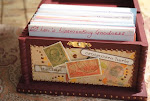 So here was the cake for my Dad's 80th birthday celebration. It was sort of a Dad's side of the family reunion. We had people here from Knoxville TN, Tucson AZ, Chilicothe OH, Columbus OH, and Haymarket VA. It was incredibly wonderful to see everybody. It has been a couple years. We played lots of games, drank sangria, laughed, ate, and ate and ate.
So here was the cake for my Dad's 80th birthday celebration. It was sort of a Dad's side of the family reunion. We had people here from Knoxville TN, Tucson AZ, Chilicothe OH, Columbus OH, and Haymarket VA. It was incredibly wonderful to see everybody. It has been a couple years. We played lots of games, drank sangria, laughed, ate, and ate and ate. The cake is a culmination of a bunch of recipes. It woreked pretty well together. It disappeared that day and the cake was 18 x 24. We had 40 people there so I would have to say it was a hit.
Double Chocolate Layer Cake
Adapted from Gourmet, March 1999
*** I saw this at Smitten Kitchen
Printable here.
For cake layers
3 ounces fine-quality semisweet chocolate such as Callebaut
1 1/2 cups hot brewed coffee
3 cups sugar
2 1/2 cups all-purpose flour
1 1/2 cups unsweetened cocoa powder (not Dutch process)
2 teaspoons baking soda
3/4 teaspoon baking powder
1 1/4 teaspoons salt
3 large eggs
3/4 cup vegetable oil
1 1/2 cups well-shaken buttermilk
3/4 teaspoon vanilla
Special equipment: two 10- by 2-inch round cake pans
Make cake layers: Preheat oven to 300°F. and grease pans. Line bottoms with rounds of wax paper and grease paper.
Finely chop chocolate and in a bowl combine with hot coffee. Let mixture stand, stirring occasionally, until chocolate is melted and mixture is smooth.
Into a large bowl sift together sugar, flour, cocoa powder, baking soda, baking powder, and salt. In another large bowl with an electric mixer beat eggs until thickened slightly and lemon colored (about 3 minutes with a standing mixer or 5 minutes with a hand-held mixer). Slowly add oil, buttermilk, vanilla, and melted chocolate mixture to eggs, beating until combined well. Add sugar mixture and beat on medium speed until just combined well.
Divide batter between pans and bake in middle of oven until a tester inserted in center comes out clean, 1 hour to 1 hour and 10 minutes.
Cool layers completely in pans on racks. Run a thin knife around edges of pans and invert layers onto racks. Carefully remove wax paper and cool layers completely. Cake layers may be made 1 day ahead and kept, wrapped well in plastic wrap, at room temperature.
The Filling:
Chocolate Pastry Cream
3 tablespoons sugar (or confectioner's sugar)
3 egg yolks
3 tablespoons flour
1/2 teaspoon vanilla
2 cups whole milk
1 tablespoon butter
2 ounces baking chocolate, grated
Place sugar, egg yolks flour, lemon rind (if using it), and vanilla in a sauce pan and mix together well.In a separate sauce pan, scald milk. Very slowly pour milk over egg yolk mixture, in a thin stream, beating constantly with rotary beater. Continue cooking on low heat, stirring with a wooden spoon, until mixture reaches the boiling point. Cook 4 minutes longer, stirring constantly. Remove pan from heat, add butter and grated chocolate and mix well. Pour into bowl and let cool, stir occasionally to prevent skin from forming over the top. If using as a cake/pastry filling, chill (with plastic wrap pressed onto the surface to prevent a skin from forming) until very thick at least 3-4 hours.
The Icing:
Hazelnut Swiss Meringue Buttercream
8 oz egg whites
16 oz sugar
1 pound butter
2 oz praline paste
1 tablespoon Nutella
1 tablespoon Frangelico
1 teaspoon vanilla
Combine egg whties and sugar in a KA mixing bowl. Whisk constantly over a pot of boiling water until the mixture reaches 140F. Remove from heat. Place mixer bowl in machine and whip on low speed until cooled. Touch the bottom of the bowl to feel temperature. When mixture is cool change from whisk attachment to beater attachment and turn up the mixer. Start adding in the butter by small chunks. Once all the butter is added put in remaining ingredients, starting with praline.
The Decorative Icing:
Chocolate Icing
*** this is a real sturdy icing that you can decorate with easily. It has great flavor without being sickeningly sweet.
2 cups powdered sugar
6 tablespoons Dutch Cocoa Powder
2 oz unsweetened chocolate, melted
3 tablespoons butter
3 tablespoons cream cheese
1/4 teaspoon vanilla
Cream the butter and cream cheese at room temperature. Temper in the melted chocolate. Sift together the powdered sugar and cocoa and combine with butter mixture at low speed. Add the vanilla and mix until fully combined.




















































